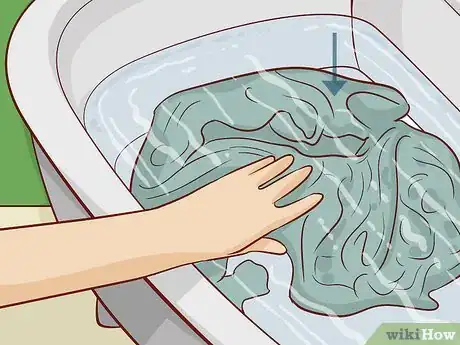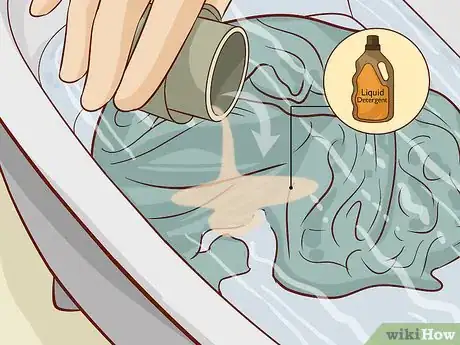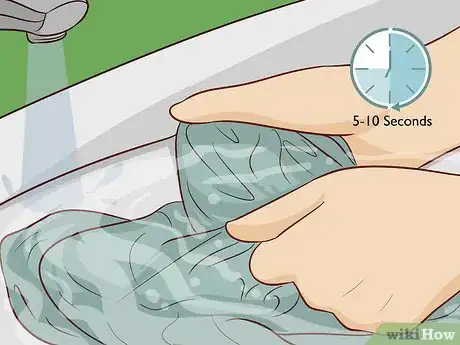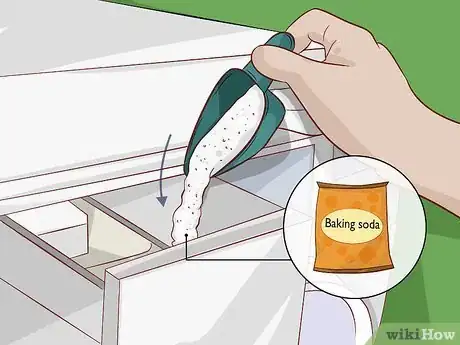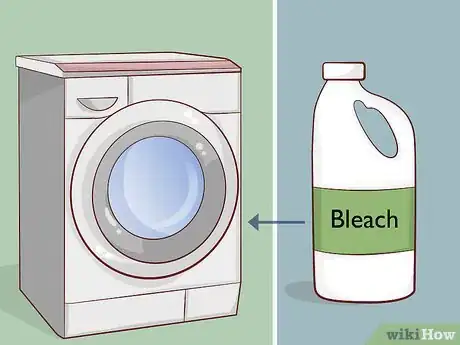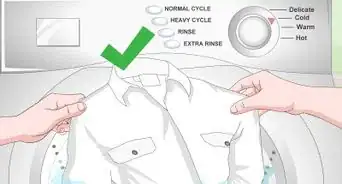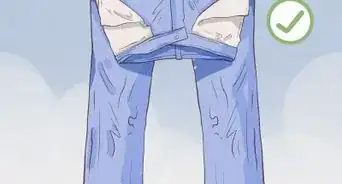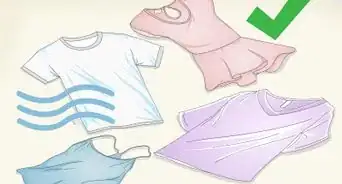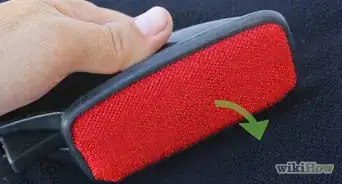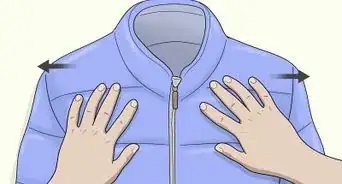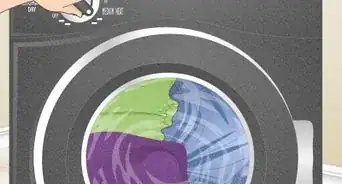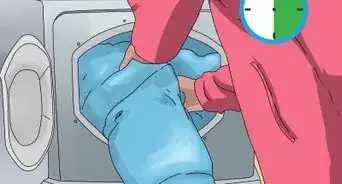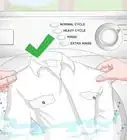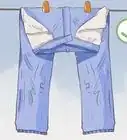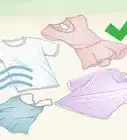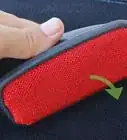This article was co-authored by Susan Stocker and by wikiHow staff writer, Eric McClure. Susan Stocker runs and owns Susan’s Green Cleaning, the #1 Green Cleaning Company in Seattle. She is well known in the region for outstanding customer service protocols — winning the 2017 Better Business Torch Award for Ethics & Integrity —and her energetic support of green cleaning practices.
There are 8 references cited in this article, which can be found at the bottom of the page.
This article has been viewed 25,243 times.
Washing machines always leave clothes perfectly clean and fresh, right? Actually, not so much. Over time, clothes can develop a build-up of soap, fabric softener, oils, and grime that even a washing machine can't get out. That's where deep cleaning, or "laundry stripping," comes in. Strip washing your clothes will help remove all of that nasty build-up and leave them as clean as when you bought them. Keep reading to learn how to deep clean your clothes, plus how to prevent build-up on them in the future.
Steps
Using the Strip Cleaning Method
-
1Wash your clothes in the machine or by hand before strip cleaning. Strip cleaning is the process of cleaning fabrics by letting them soak over 4-8 hours. Before strip cleaning your clothing, either rinse your clothes under cold water and wring them out by hand. Alternatively, you can throw your clothes in the washing machine and rinse them. The more residue and dirt you remove before strip cleaning, the more efficient the process will be.[1]
- Strip cleaning is not recommended for dyed clothing.
- You can strip clean clothing that says “hand wash only” on the label, but avoid using hot water if the tag says “cold water only.”
- Strip cleaning is often used to remove dirt and bacteria from bulky materials like sheets, jackets, rugs, and cushions. You can strip clean most clothing items, though.
- You can strip clean any amount of clothes, but this process will work best with a smaller amount of clothing. Do not strip clean colors and whites at the same time.
-
2Fill your bathtub or sink halfway with hot water and add your clothes. Most people strip-clean their clothes in the tub, but you can use a sink if you prefer. Turn the hot water on and set it to the highest temperature possible. Once the water reaches its hottest temperature, add your clothes and plug your drain with a stopper. Fill the tub or sink halfway with hot water before shutting it off.[2]
- If you’re strip cleaning a lot of clothing, add enough water to fully submerge the clothing.
Advertisement -
3Add 1⁄2–1 cup (120–240 mL) of liquid detergent to the water and stir. You can use any liquid detergent for your clothing. Pour 1⁄2–1 cup (120–240 mL) of liquid detergent into the water based on the level of dirt or grime on your clothing. Then, either move your clothing around in the water or use a wooden spoon to stir the clothing. Continue stirring until the water is soapy and bubbly.[3]
Variation: If you’re washing an item covered in grease or oil, add a squirt of dish soap to the water before mixing. For an even deeper clean, add a small scoop of stain-remover or laundry booster to the water. Use half of the recommended amount as listed on your particular brand of stain-remover or laundry booster.[4]
-
4Soak your clothes for at least 4 hours, stirring occasionally. To give the cleaning agent time to work its way into the fabric, let your clothes sit in the water for at least 4 hours. Stir the clothes by hand or with a wooden spoon at least once every 30-60 minutes.[5]
- The water will change colors as your item soaks. This is perfectly normal and it’s a sign that the process is working as intended.
- If you really want to get your clothes as clean as possible, you can soak the clothes for up to 8 hours.
-
5Refill the sink or tub with warm water every 1-2 hours. When the water temperature in your tub or sink reaches room temperature, refill the tub with new hot water. Do not add any additional detergent. Mix your clothes into the new water whenever you replace it.[6]
-
6Drain the tub or sink and squeeze the excess water out. After your clothing has soaked for 4-8 hours, remove the stopper to drain your water. Turn the hot water in your tub on and rinse your clothing for 5-10 seconds to remove any soapy residue. Then, wring your clothes out or squeeze the fabric until you’ve removed the majority of the excess water.[7]
- You do not need to remove all of the water, but your clothing shouldn’t be dripping wet.
- Don’t stretch your clothing to remove water. Avoid wringing sensitive fabrics.
-
7Wash your clothes in the washing machine using water only. Once you’ve removed most of the water from your clothing, take your textiles to the washing machine. Set your clothes inside of the washing machine and run a wash cycle. Use the normal wash setting for standard clothes or the “delicates” setting for sensitive fabrics. Do not add any detergent or soap.[8]
- This will thoroughly rinse the detergent out of your fabric and ensure that any residue or buildup is completely removed.
-
8Dry your clothes in the machine or let them air dry. If you want to dry your clothes quickly, toss them in the dryer and run a standard dry cycle. If you want your clothes to remain totally clean, air dry them on a clothing line or hangers.[9]
- Machine-drying your clothes may accidentally add lint, dust, or soap residue into the fabric of your clothing. If your dryer isn’t particularly dirty though, you shouldn’t notice a big difference.
Changing the Way You Wash
-
1Turn your clothes inside-out before washing them. Before loading your washing machine, turn each clothing item inside-out. Washing your clothes the same way that you wear them may trap sweat, dirt, or other contaminants inside of the clothes as they wash. Turning your clothes inside-out will ensure that the detergent interacts with the dirtiest part of your clothes though, which makes the cleaning process more efficient.[10]
-
2Add 1⁄2 cup (120 mL) of white vinegar to remove buildup. Wash your clothes the way that you normally do. Pause the wash cycle after the water has drained from your machine but before the rinse cycle starts. Then, open the lid to your washing machine and pour 1⁄2 cup (120 mL) of white vinegar into the drum. Finish your wash cycle before air or machine drying your clothes.[11]
- Do not mix white vinegar into your wash cycle if you used bleach. This will create a toxic gas.
- The white vinegar will remove the residue left behind by your laundry detergent and eat through any odors trapped in your clothes.
-
3Add 1/4 cup (45 g) of baking soda to your wash cycle to remove odors. If your clothes retain odors even after you wash and dry them, add baking soda to your wash cycle. Load your clothes and add your laundry detergent. Then, once your drum is half-full with water, pour 1/4 cup (45 g) of baking soda into your machine. The baking soda will absorb any odor-causing bacteria as you wash your clothes.[12]
Variation: If you plan on using white vinegar as well, pour the vinegar in at the beginning of your wash cycle. Then, add the baking soda to the rinse cycle and skip the laundry detergent entirely. Do not add vinegar and baking soda at the same time or your machine may overflow with bubbles and foam.
-
4Wash especially dirty fabrics by hand after wearing them. Swimsuits, delicate underwear, and workout gear become harder to clean if they’re allowed to sit in the laundry basket or air dry before they’re cleaned. Wash these fabrics by hand after wearing them. Add 1 teaspoon (4.9 mL) of dish soap to a bucket or sink filled with room-temperature water. Submerge your clothing and massage it by hand for 5-10 minutes. Then, rinse the clothes and squeeze the fabric gently to remove the excess water. Let the clothing air dry or add them to your machine for a standard wash cycle.[13]
- Alternatively, you can let the clothes soak for 30 minutes instead of massaging them by hand.
-
5Use bleach to keep white clothes bright and clean. Bleach is a phenomenal cleaning agent, but you can only use it on white clothing. To use bleach in your wash cycle, wait for the wash cycle to start. After the cycle runs for 5 minutes, add 1⁄4–1⁄2 cup (59–118 mL) of bleach to your dispenser or pour it directly into your drum. Finish washing your clothes before machine or air drying them as you normally do.[14]
- If you add the bleach at the beginning of your wash cycle, it may neutralize the laundry detergent.
Expert Q&A
-
QuestionHow do you remove armpit stains from shirts?
 Susan StockerSusan Stocker runs and owns Susan’s Green Cleaning, the #1 Green Cleaning Company in Seattle. She is well known in the region for outstanding customer service protocols — winning the 2017 Better Business Torch Award for Ethics & Integrity —and her energetic support of green cleaning practices.
Susan StockerSusan Stocker runs and owns Susan’s Green Cleaning, the #1 Green Cleaning Company in Seattle. She is well known in the region for outstanding customer service protocols — winning the 2017 Better Business Torch Award for Ethics & Integrity —and her energetic support of green cleaning practices.
Cleaning Professional Lemon juice works wonders! Mix 1 part lemon juice with 1 part warm water (use a real lemon for this). Then, scrub until the stain disappears. You can also try a mixture of baking soda and water.
Lemon juice works wonders! Mix 1 part lemon juice with 1 part warm water (use a real lemon for this). Then, scrub until the stain disappears. You can also try a mixture of baking soda and water. -
QuestionHow do you deodorize clothes?
 Susan StockerSusan Stocker runs and owns Susan’s Green Cleaning, the #1 Green Cleaning Company in Seattle. She is well known in the region for outstanding customer service protocols — winning the 2017 Better Business Torch Award for Ethics & Integrity —and her energetic support of green cleaning practices.
Susan StockerSusan Stocker runs and owns Susan’s Green Cleaning, the #1 Green Cleaning Company in Seattle. She is well known in the region for outstanding customer service protocols — winning the 2017 Better Business Torch Award for Ethics & Integrity —and her energetic support of green cleaning practices.
Cleaning Professional The best way to deodorize clothes is to wash them after each wearing. It is easier to remove odor when there is not build-up. Think about it this way: it’s easier to keep a stove grease-free if you wipe it down daily—the same thing goes with your clothes. When you do have strong odors, use a cup of vinegar in your wash. Vinegar is a natural, amazing deodorizer that is highly effective!
The best way to deodorize clothes is to wash them after each wearing. It is easier to remove odor when there is not build-up. Think about it this way: it’s easier to keep a stove grease-free if you wipe it down daily—the same thing goes with your clothes. When you do have strong odors, use a cup of vinegar in your wash. Vinegar is a natural, amazing deodorizer that is highly effective! -
QuestionIs handwashing clothes effective?
 Susan StockerSusan Stocker runs and owns Susan’s Green Cleaning, the #1 Green Cleaning Company in Seattle. She is well known in the region for outstanding customer service protocols — winning the 2017 Better Business Torch Award for Ethics & Integrity —and her energetic support of green cleaning practices.
Susan StockerSusan Stocker runs and owns Susan’s Green Cleaning, the #1 Green Cleaning Company in Seattle. She is well known in the region for outstanding customer service protocols — winning the 2017 Better Business Torch Award for Ethics & Integrity —and her energetic support of green cleaning practices.
Cleaning Professional It absolutely is effective and is great for washing delicates such as lingerie or silk. Be careful when washing that you do not over scrub—if you do, you can damage the fibers, and even rip the items. Be careful to give extra attention to the underarm area, and let the garment soak long enough in the sink to let the cleaning ingredient have time to work its magic.
It absolutely is effective and is great for washing delicates such as lingerie or silk. Be careful when washing that you do not over scrub—if you do, you can damage the fibers, and even rip the items. Be careful to give extra attention to the underarm area, and let the garment soak long enough in the sink to let the cleaning ingredient have time to work its magic.
Things You’ll Need
Using the Strip Cleaning Method
- Water
- Sink or tub
- Laundry detergent
- Wooden spoon (optional)
- Dish soap (optional)
- Laundry booster (optional)
Changing the Way You Wash
- White vinegar
- Baking soda
- Bleach
- Laundry detergent
References
- ↑ http://www.fortheloveofclean.com/laundry-love/special/strip-deep-clean-or-sanitize/deep-clean/
- ↑ https://youtu.be/r7iW4jK7-tc?t=22
- ↑ http://www.fortheloveofclean.com/laundry-love/special/strip-deep-clean-or-sanitize/deep-clean/
- ↑ http://www.fortheloveofclean.com/laundry-love/special/strip-deep-clean-or-sanitize/deep-clean/
- ↑ https://youtu.be/r7iW4jK7-tc?t=41
- ↑ https://youtu.be/r7iW4jK7-tc?t=41
- ↑ http://www.fortheloveofclean.com/laundry-love/special/strip-deep-clean-or-sanitize/deep-clean/
- ↑ https://youtu.be/r7iW4jK7-tc?t=64
- ↑ http://www.fortheloveofclean.com/laundry-love/special/strip-deep-clean-or-sanitize/deep-clean/
- ↑ https://www.esquire.com/style/advice/a44472/how-to-wash-your-jeans/
- ↑ https://www.nytimes.com/2018/05/30/smarter-living/how-to-clean-your-gross-workout-gear.html
- ↑ https://www.nytimes.com/2018/05/30/smarter-living/how-to-clean-your-gross-workout-gear.html
- ↑ https://www.goodhousekeeping.com/home/cleaning/g26018107/items-that-need-deep-cleaning/
- ↑ https://www.goodhousekeeping.com/home/cleaning/a24670/3-secrets-to-keeping-your-whites-white/

